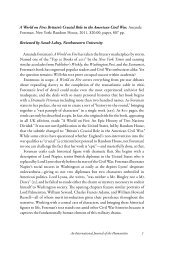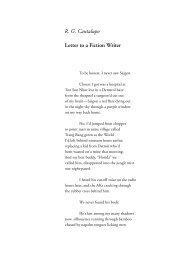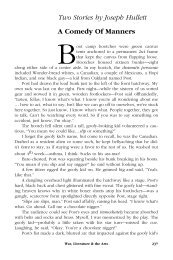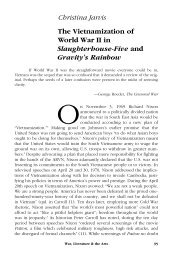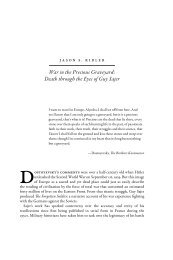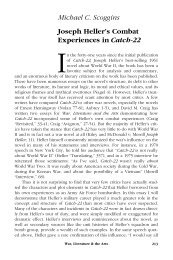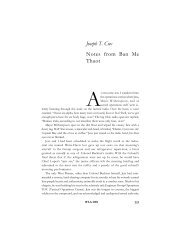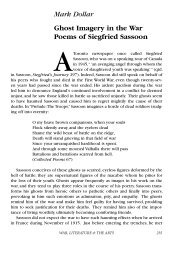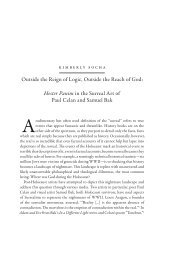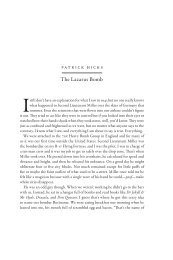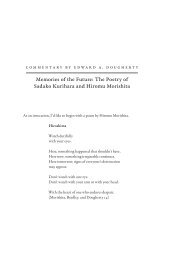C. Kenneth Pellow - War, Literature and the Arts
C. Kenneth Pellow - War, Literature and the Arts
C. Kenneth Pellow - War, Literature and the Arts
You also want an ePaper? Increase the reach of your titles
YUMPU automatically turns print PDFs into web optimized ePapers that Google loves.
130 WLA 2001<br />
C. <strong>Kenneth</strong> <strong>Pellow</strong><br />
Analogy in Regeneration<br />
About a quarter of <strong>the</strong> way<br />
through Pat Barker’s Regeneration,<br />
<strong>the</strong> psycho<strong>the</strong>rapist Will<br />
iam H.R. Rivers has a disturbing<br />
dream. When he has awakened from it, Rivers—not surprisingly—<br />
analyzes it. In <strong>the</strong> dream, Rivers saw himself when, as a much younger<br />
man, he conducted a series of experiments on nerve regeneration with<br />
fellow-neurologist Henry Head. Their work (one of Barker’s many borrowings<br />
from “real” life) involved <strong>the</strong> severing of a nerve in Head’s forearm<br />
<strong>and</strong> <strong>the</strong> close observation of <strong>the</strong> regenerative process. The dream in<br />
<strong>the</strong> novel has been “factual” enough, except for Head’s saying to Rivers<br />
“Why don’t you try it?” <strong>and</strong> <strong>the</strong>n slicing Rivers’ arm. Eventually, Rivers<br />
arrives at an interpretation of that part of <strong>the</strong> dream. He makes a quite<br />
decent analogy between <strong>the</strong> work he had done with Head <strong>and</strong> <strong>the</strong> work<br />
he does at Craiglockhart military hospital. Central to his analogy is his<br />
teaching his Craiglockhart patients to acknowledge fear <strong>and</strong> repression.<br />
That is what he imagines <strong>the</strong> “Head” of his dream is urging him to “try”<br />
(45-8). However, he misses <strong>the</strong> truly central aspect: i.e., Rivers does not<br />
go to war; he does not “try” that portion of his patients’ lives that causes<br />
<strong>the</strong> trauma from which <strong>the</strong>y suffer. He is accurate in <strong>the</strong> dimension of <strong>the</strong><br />
dream that he has perceived, but he has not seen <strong>the</strong> whole analogy.<br />
This episode reveals much of Barker’s <strong>the</strong>me, but, more than that, it also<br />
reveals much of her method, for in this novel analogies are a key method<br />
to underst<strong>and</strong>ing.<br />
The plot of this novel mainly retains historical reality. The first of a<br />
trilogy (of which <strong>the</strong> last, The Ghost Road, would win a Booker Prize),<br />
Regeneration looks in on Rivers <strong>and</strong> Craiglockhart just as Siegfried Sassoon<br />
has been sent <strong>the</strong>re, in <strong>the</strong> summer of 1917, following <strong>the</strong> issuance of his
131<br />
famous “Declaration,” in which Sassoon, a much-decorated, heroic British<br />
officer, in protest against a war he saw as being “deliberately prolonged”<br />
by those with <strong>the</strong> power to end it, declared that he would “no<br />
longer be a party” to it. It is Rivers’ job to bring about psycho<strong>the</strong>rapeutic<br />
“cures” in his patients; when <strong>the</strong>y are “cured,” <strong>the</strong>y are not generally<br />
released to civilian life but returned to battle. Sassoon becomes his patient.<br />
The novel focuses primarily upon Rivers <strong>and</strong> generally follows him<br />
throughout his arduous duties. Only occasionally, <strong>and</strong> briefly, are <strong>the</strong><br />
thoughts of o<strong>the</strong>r characters revealed, while those of Rivers are dwelt<br />
upon at some length <strong>and</strong> in ra<strong>the</strong>r considerable detail. The main crisis is<br />
his, <strong>and</strong> it too is borrowed from real life. The historical Dr. Rivers, 1 in<br />
Conflict <strong>and</strong> Dream, spoke of a “fear” that bo<strong>the</strong>red him when at Craiglockhart:<br />
“<strong>the</strong> situation that would arise if my task of converting a patient from his<br />
‘pacifist errors’ to <strong>the</strong> conventional attitude should have as its result my<br />
own conversion to his point of view” (168). 2 The novel’s Rivers endures<br />
<strong>the</strong> same trial, more-or-less overcomes it, <strong>and</strong> at <strong>the</strong> end, oversees <strong>the</strong><br />
return of Sassoon to active duty.<br />
Not surprisingly, for this is a novel about persons involved in psychoanalytic<br />
processes, Regeneration is mostly made up of scenes between two<br />
characters. Most of <strong>the</strong>se are “sessions” between Rivers <strong>and</strong> his various<br />
patients, but, session or not, by far <strong>the</strong> greater part of <strong>the</strong> novel is composed<br />
of <strong>the</strong>se two-party encounters. Always at <strong>the</strong> center is <strong>the</strong> Rivers-<br />
Sassoon relationship, for it is not only <strong>the</strong> one that raises <strong>the</strong> main questions<br />
that generate <strong>and</strong> sustain <strong>the</strong> plot—Will Rivers succeed in “curing”<br />
Sassoon? Will Sassoon be returned to duty? Will he change <strong>the</strong> views he<br />
expressed in <strong>the</strong> “Declaration”?—but also <strong>the</strong> relationship that is crucial<br />
to <strong>the</strong>me, for it is <strong>the</strong> encounter that causes <strong>the</strong> fictional Rivers to ponder<br />
<strong>the</strong> same question confronted by <strong>the</strong> real Rivers regarding “conversion”<br />
of himself or <strong>the</strong> patient. While that pairing occupies <strong>the</strong> narrative <strong>and</strong><br />
<strong>the</strong>matic center, practically every o<strong>the</strong>r two-party encounter in Barker’s<br />
novel relates to it in some crucial way. Constantly, by analogy, <strong>the</strong> main<br />
issues between Rivers <strong>and</strong> Sassoon are emphasized, <strong>and</strong> clarified, <strong>and</strong><br />
amplified by <strong>the</strong> issues that connect <strong>and</strong>/or divide <strong>the</strong> o<strong>the</strong>r pairs.<br />
The relationship between Rivers <strong>and</strong> Sassoon is, naturally, that between<br />
<strong>the</strong>rapist <strong>and</strong> patient, as well as between captain <strong>and</strong> second lieutenant.<br />
Symbolically, it grows into a confrontation, but also a collaboration,<br />
between fa<strong>the</strong>r <strong>and</strong> son. Not so clearly at first, but more obviously<br />
with time, it is a “win-lose” relationship: one must triumph <strong>and</strong> <strong>the</strong> o<strong>the</strong>r<br />
give in. Finally, it becomes a rewarding if somewhat uneasy friendship in
132<br />
WLA 2001<br />
which each becomes, to some extent, <strong>the</strong> o<strong>the</strong>r’s conscience. If we look<br />
first at <strong>the</strong> various ways in which this relationship plays out, we can <strong>the</strong>n<br />
go on to see how several of <strong>the</strong> o<strong>the</strong>rs enrich it by reflecting <strong>and</strong> amplifying<br />
it.<br />
Rivers’ commitment, in <strong>the</strong> early stages of <strong>the</strong> novel, is firm. His responsibility,<br />
as he sees it, is to <strong>the</strong> government <strong>and</strong> <strong>the</strong> people of Great<br />
Britain, in whose army he serves. As he will say much later in <strong>the</strong> novel,<br />
to Ruth Head, <strong>the</strong> novel-writing wife of Henry Head with whom Rivers<br />
had worked on nerve regeneration: “I wear <strong>the</strong> uniform, I take <strong>the</strong> pay,<br />
I do <strong>the</strong> job. I’m not going to apologize for that.” (164) 3 Consequently, he<br />
also feels a commitment to <strong>the</strong> war effort. That being <strong>the</strong> case, his responsibility<br />
to his patients is to aid <strong>the</strong>m in overcoming whatever particular<br />
“war neurosis” has incapacitated each of <strong>the</strong>m, but mainly so that<br />
each can be made sufficiently fit to be returned to full duty. This obligation<br />
creates a considerably more ambivalent <strong>the</strong>rapist/patient relationship<br />
than would be <strong>the</strong> case under more normal circumstances, <strong>and</strong><br />
Rivers is far too perceptive (<strong>and</strong> too much an ironist) not to be aware of<br />
this ambivalence, which—up to <strong>the</strong> arrival of Sassoon, at least—he has<br />
mainly succeeded in accepting. However, Sassoon represents, as Rivers,<br />
by mid-treatment, will acknowledge, “Not an easy case.... Not in <strong>the</strong><br />
usual sense a case at all” (118). What makes his not a “case” is that what<br />
got him to Craiglockhart is his “Declaration.” One may disagree with <strong>the</strong><br />
principles <strong>and</strong>/or <strong>the</strong> facts that he cites in that document, but it hardly<br />
seems <strong>the</strong> work of anyone incapacitated by any kind of neurosis. It is<br />
rationally argued, perfectly coherent, <strong>and</strong> quite cogent. The <strong>War</strong> Board<br />
that sent him to Craiglockhart, partly at <strong>the</strong> urging of Sassoon’s “friend”<br />
Robert Graves had perhaps no choices beyond sending him for treatment<br />
or recommending a court-martial. In sending him to <strong>the</strong> hospital, <strong>the</strong><br />
board left Rivers no g ood choices ei<strong>the</strong>r; he must now treat a patient<br />
whose “illness” is a rhetorically elegant protest. True, Sassoon had also<br />
had episodes of nightmares <strong>and</strong> apparent hallucinations, but so did thous<strong>and</strong>s<br />
of soldiers who had undergone his experience. The real-life Sassoon<br />
was well aware of <strong>the</strong> illogic of his situation. As he recalls in Seigfried’s<br />
Journey:<br />
...<strong>the</strong> Under-Secretary for <strong>War</strong> had told <strong>the</strong> House of Commons<br />
that I was suffering from a nervous breakdown, unavoidably<br />
ignoring <strong>the</strong> fact that people in such a condition don’t usually<br />
do things requiring moral courage. (56-7)
133<br />
Rivers is cognizant of this anomaly from <strong>the</strong> start. In his first interview<br />
with Sassoon, he makes it clear: “...I don’t even think you’ve got a war<br />
neurosis....You seem to have a very powerful anti-war neurosis” (15).<br />
After <strong>the</strong>y’ve shared a laugh over this, Rivers makes <strong>the</strong> rest of his opinion<br />
no less clear: “You realize, don’t you, that it’s my duty to... to try to<br />
change that? I can’t pretend to be neutral” (15; ellipsis in text).<br />
From <strong>the</strong> beginning, <strong>the</strong>n, this is an unusual <strong>the</strong>rapist/patient relationship.<br />
In this instance, Rivers must not so much bring about a recognition<br />
by a “patient” of those forces unconsciously restraining his normal capabilities;<br />
he must instead talk someone out of a consciously adopted philosophical<br />
(<strong>and</strong> political) position. A third party, Rivers’ colleague Brock,<br />
raises this oddity in a conference of all Craiglockhart’s medical officers.<br />
Brock wants to know, regarding Sassoon, whe<strong>the</strong>r <strong>the</strong>re is not “a case for<br />
leaving him alone.” Rivers responds that <strong>the</strong>re is no such case: “He’s a<br />
mentally <strong>and</strong> physically healthy man. It’s his duty to go back, <strong>and</strong> it’s my<br />
duty to see he does” (73). The position Sassoon has adopted, Rivers<br />
contends, is influenced by emotion <strong>and</strong> is one he holds inconsistently,<br />
thus creating “all <strong>the</strong> more reason to get him to argue <strong>the</strong> position.” When<br />
Brock wonders aloud how this will be done, Rivers responds, “Rationally”<br />
(74). Before long, Sassoon has recognized this as well. After a brief while<br />
at <strong>the</strong> hospital, he comes to think that he has “given in, lapsed,” that he<br />
has “let himself be pacified.” He is being won over, he fears, just “[a]s<br />
Rivers had meant him to be” (114). It is precisely this wrench in <strong>the</strong><br />
ordinary <strong>the</strong>rapeutic process that gives Barker’s novel much of its drama,<br />
as it shifts <strong>the</strong> dilemma from Sassoon to Rivers. Conscientious <strong>and</strong> selfaware,<br />
Rivers knows that he has had “to express views he was no longer<br />
sure he held.” Such breakdowns as he treats are not, he knows, <strong>the</strong> result<br />
of any “innate weakness” in <strong>the</strong> men, but of <strong>the</strong> war itself (115). He has<br />
“survived partly by suppressing” this awareness. But now <strong>the</strong> presence of<br />
Sassoon makes “<strong>the</strong> justifiability of <strong>the</strong> war a matter for constant, open<br />
debate,” <strong>and</strong> that suppression has become “no longer possible” (116).<br />
While Rivers remains determined to “get Siegfried to give in,” (118) he<br />
also comes to like him <strong>and</strong> to respect him “too much to manipulate him”<br />
(119). Their interaction leads each to recall his own fa<strong>the</strong>r. It is not surprising<br />
that <strong>the</strong>ir relationship, even were <strong>the</strong>re not <strong>the</strong> difference in <strong>the</strong>ir<br />
respective ages, would take on aspects of fa<strong>the</strong>r-<strong>and</strong>-son; <strong>the</strong> psycho<strong>the</strong>rapeutic<br />
situation is often “parental,” both in its dem<strong>and</strong>s <strong>and</strong> in its<br />
potential for nurturing. But fa<strong>the</strong>r-son issues surround <strong>the</strong>se two even
134<br />
WLA 2001<br />
more than might be expected. Sassoon is in several ways fa<strong>the</strong>rless. His<br />
fa<strong>the</strong>r was Jewish, but Siegfried was not brought up as a Jew, <strong>and</strong> he has<br />
had absolutely no encouragement to pursue his fa<strong>the</strong>r’s heritage. The<br />
elder Sassoon left <strong>the</strong> family when Siegfried was five years old, <strong>the</strong>n died<br />
three years later. When he arrives at Craiglockhart, Sassoon feels sold out<br />
by his fa<strong>the</strong>rl<strong>and</strong>, <strong>and</strong> he is inclined to see older men as most responsible<br />
for that betrayal. Looking at all <strong>the</strong> elder citizens at Rivers’ club, where he<br />
is a guest, Sassoon perceives “mingled admiration <strong>and</strong> apprehension”<br />
emanating from <strong>the</strong>m. “Old men were often ambivalent about young<br />
men in uniform, <strong>and</strong> rightly so, when you considered how very ambivalent<br />
<strong>the</strong> young men felt about <strong>the</strong>m” (113).<br />
As we shall see shortly, this is a perception that will—more fully <strong>and</strong><br />
deeply—occur later to Rivers. Meanwhile, Sassoon moves toward an<br />
awareness of <strong>the</strong> role that Rivers is occupying in his life. The night before<br />
Rivers is due to depart on a three-week leave, Sassoon has an hallucination<br />
(or a nightmare; it is not perfectly clear that he is awake) in which he<br />
is visited by a deceased comrade. Upon rising in <strong>the</strong> morning, he seeks<br />
Rivers, finds that he has already left, <strong>and</strong> feels a “sense of loss” (144).<br />
Looking into a mirror while he washes up, he recalls looking into a<br />
similar mirror when he was a five-year-old child, probably on <strong>the</strong> very<br />
day when “his fa<strong>the</strong>r left home.” Sassoon smiles, “amused at <strong>the</strong> link” he<br />
has made, <strong>the</strong>n more soberly realizes “only now, faced with this second<br />
ab<strong>and</strong>onment... how completely Rivers ha[s] come to take his fa<strong>the</strong>r’s<br />
place” (145).<br />
Immediately following this scene, we see Rivers, now on leave from<br />
<strong>the</strong> hospital, pondering his own thoughts during a church service. Two<br />
icons arrest his w<strong>and</strong>ering gaze: <strong>the</strong> crucifixion <strong>and</strong> a picture of Abraham<br />
about to sacrifice Isaac. These represent, for Rivers, “<strong>the</strong> two bloody<br />
bargains on which a civilization claims to be based.” Yet it is Abraham’s<br />
readiness to do in his son that represents, in Rivers’ mind, <strong>the</strong> bargain:<br />
The one on which all patriarchal societies are founded. If<br />
you, who are young <strong>and</strong> strong, will obey me, who am old<br />
<strong>and</strong> weak, even to <strong>the</strong> extent of being prepared to sacrifice<br />
your life, <strong>the</strong>n in <strong>the</strong> course of time you will peacefully inherit,<br />
<strong>and</strong> be able to exact <strong>the</strong> same obedience from your sons.<br />
At this historical moment, however, Rivers feels that <strong>the</strong> bargain is<br />
being broken, since “old men, <strong>and</strong> women of all ages” are ga<strong>the</strong>ring to
135<br />
sing hymns, while “[a]ll over nor<strong>the</strong>rn France,” <strong>the</strong> would-be “inheritors”<br />
are dying (149). Rivers goes from <strong>the</strong> church to his bro<strong>the</strong>r’s home, where<br />
he recognizes some of <strong>the</strong> furniture as being from <strong>the</strong>ir childhood home,<br />
including a picture that hung “in his fa<strong>the</strong>r’s study” (153). This item,<br />
remindful to <strong>the</strong> reader of Sassoon’s mirror, leads him to remember his<br />
fa<strong>the</strong>r’s doing speech <strong>the</strong>rapy with stammerers, including Charles Dodgson<br />
<strong>and</strong> <strong>the</strong> young Rivers himself, <strong>and</strong> to remember also various ways in<br />
which he had rebelled against his fa<strong>the</strong>r’s authority (154-5). He realizes<br />
how complex <strong>and</strong> unending is <strong>the</strong> relationship of fa<strong>the</strong>r <strong>and</strong> son, <strong>and</strong><br />
that recently he has “thought more about his fa<strong>the</strong>r than he’d done since<br />
he was a child.” The parallel does not escape him between his fa<strong>the</strong>r’s<br />
working with stuttering patients <strong>and</strong> his doing <strong>the</strong> same at Craiglockhart. 4<br />
But <strong>the</strong> parallel breaks down, Rivers also realizes, in his not having a son.<br />
Immediately that reminds him that an “unfinished letter to Siegfried” is<br />
on his desk, <strong>and</strong> he at once sits down to resume that letter (156).<br />
The parental-filial nature of <strong>the</strong>ir relationship does not just occur to<br />
Rivers <strong>and</strong> Sassoon in private thoughts when <strong>the</strong>y are apart; in <strong>the</strong> late<br />
stages of <strong>the</strong> novel, it is observable—not always positively—to both of<br />
<strong>the</strong>m. The scene that sets <strong>the</strong> novel in <strong>the</strong> direction of resolution comes<br />
at <strong>the</strong> end of Part 3 (of four), in which Sassoon confides to Rivers—he<br />
has told no one else—that he intends to return to combat. He almost<br />
desperately seeks to know that Rivers is pleased at his decision, <strong>and</strong> as<br />
he asks him directly, he is “looking at Rivers with an extraordinary mixture<br />
of love <strong>and</strong> hostility,” <strong>the</strong> way in which many a son in any culture or<br />
era has looked at his fa<strong>the</strong>r, <strong>the</strong> way Sassoon earlier looked at old men in<br />
general, <strong>and</strong> <strong>the</strong> way, no doubt, in which Isaac looked at Abraham.<br />
Sassoon gets his wish: Rivers is pleased (190). Still later, however, <strong>the</strong>y<br />
come to a sharp disagreement over whe<strong>the</strong>r a young homosexual friend<br />
of Graves’ ought to be treated for homosexuality, whe<strong>the</strong>r he is in need<br />
of being “cured” (204). As that chapter ends, Sassoon dem<strong>and</strong>s to know<br />
if he must be expected to “conform” in all areas of his life, even those in<br />
which conforming goes against his conscience. He insists that he cannot<br />
live like that, <strong>the</strong>n adds: “Nobody should live like that.” He gets from<br />
Rivers a reply of <strong>the</strong> type that, at one time or ano<strong>the</strong>r, perhaps every<br />
young man has heard—<strong>and</strong> resented hearing—from his fa<strong>the</strong>r:<br />
‘You spend far too much time tilting at windmills, Siegfried. In<br />
ways which do you a great deal of damage—which I happen to<br />
care about—<strong>and</strong> don’t do anybody else any good at all.’ He
136<br />
WLA 2001<br />
hesitated, <strong>the</strong>n said it anyway. ‘It’s time you grew up. Started<br />
living in <strong>the</strong> real world.’ (205)<br />
Throughout much of <strong>the</strong> foregoing, one must bear in mind that, while<br />
<strong>the</strong> Rivers-Sassoon pairing may have a powerful fa<strong>the</strong>r-son component, it<br />
also has a strong dimension of “win-lose.” Theirs is a zero-sum game.<br />
Given <strong>the</strong>ir initial goals (Rivers’ to return this soldier to duty, Sassoon’s to<br />
“no longer be a party” to an “evil <strong>and</strong> unjust” war), one of <strong>the</strong>m can<br />
triumph only at <strong>the</strong> o<strong>the</strong>r’s expense. Indeed, one might see <strong>the</strong>irs as a<br />
double win-lose match, since <strong>the</strong>re is <strong>the</strong> danger for Sasoon that he will<br />
not only return to <strong>the</strong> front but will be dissuaded from his opposition to<br />
<strong>the</strong> war <strong>and</strong> for Rivers that he will fail at restoring Sassoon to duty <strong>and</strong> in<br />
<strong>the</strong> process be converted to Sassoon’s anti-war view. That <strong>the</strong>y are to<br />
some degree in competition is more-or-less acknowledged between <strong>the</strong>m<br />
early on. When Rivers expresses <strong>the</strong> opinion that <strong>the</strong>re is “nothing more<br />
despicable than using a man’s private life to discredit his views,” Sassoon’s<br />
only partly joking rejoinder is “I thought discrediting my views was what<br />
you were about?” (55). Again, <strong>the</strong> psychoanalytic process is, by its nature,<br />
partly competitive. One recalls Freud’s rationale for not undergoing<br />
analysis himself: he would be constantly “ahead” of any analyst. At times<br />
we see Rivers staying similarly “one up” on Sassoon, as when <strong>the</strong> latter<br />
attempts to guess what Graves has told Rivers about him: “What a fine<br />
upst<strong>and</strong>ing man I was until I fell among pacifists. Isn’t that right? [Bertr<strong>and</strong>]<br />
Russell used me. Russell wrote <strong>the</strong> Declaration.” Rivers replies, “No, he<br />
didn’t say that” (53). The one truly honest part of Rivers’ reply is “that,” if<br />
“that” be taken to mean Sassoon’s final sentence. Graves did not accuse<br />
Russell of writing Sassoon’s “Declaration,” but as <strong>the</strong> reader has already<br />
seen, he did (21-23, especially 23) say to Rivers <strong>the</strong> rest of what Sassoon<br />
has guessed. Ruth Head later detects accurately how this aspect of <strong>the</strong><br />
process is going when she insists to Rivers that Sassoon’s return to combat<br />
ought to be by his own choice. Rivers insists “It is his choice,” but<br />
Ruth merely smiles <strong>and</strong> shakes her head. (164). Shortly, we will look<br />
again at this win-lose motif in ano<strong>the</strong>r context.<br />
The most remarkable thing about Rivers <strong>and</strong> Sassoon in Regeneration is<br />
<strong>the</strong> manner in which each influences <strong>the</strong> o<strong>the</strong>r so much that each virtually<br />
becomes <strong>the</strong> o<strong>the</strong>r’s conscience. This is first seen when Sassoon<br />
begins addressing remarks to Rivers when <strong>the</strong>y are not toge<strong>the</strong>r. After<br />
Sassoon has completed a round of golf with ano<strong>the</strong>r patient, he contem-
plates a moment that took place on <strong>the</strong> course, when his opponent threatened<br />
him with a golf club:<br />
He conjured Rivers up in his mind <strong>and</strong> asked, What was that you<br />
were saying about ‘safety’? Nothing more dangerous than playing golf with lunatics.<br />
‘Lunatics’ was a word Sassoon would never have dared use to<br />
Rivers’ face, so it gave him an additional pleasure to yell it at his<br />
image. (85)<br />
137<br />
Rivers is similarly affected by his discussions with Sassoon, <strong>and</strong> eventually<br />
<strong>the</strong>y have almost exchanged places, in regard to one’s being searching<br />
<strong>and</strong> inquisitive <strong>and</strong> <strong>the</strong> o<strong>the</strong>r’s being defensively reticent. In a later<br />
deliberate “provocation” of Rivers, Sassoon speaks of himself as being in<br />
a “loony-bin.” When that gets no response,he observes that “‘things like<br />
this... happening to people’” he knows makes it “‘quite difficult to go<br />
on... with <strong>the</strong> protest.’” When even this gets no comeback, he leans<br />
forward <strong>and</strong> prods, “Wake up, Rivers. I thought you’d pounce on that,” to<br />
which Rivers can only reply wearily “I don’t feel much like pouncing”<br />
(118).<br />
In <strong>the</strong> novel’s last ten pages, Rivers becomes convinced that his<br />
Craiglockhart experience has changed him. Actually, some change in<br />
him is first perceived by Ruth <strong>and</strong> Henry Head. When Henry points this<br />
out to him, Rivers recalls an analogous time in his life. On his way back<br />
from <strong>the</strong> Solomon Isl<strong>and</strong>s, he had engaged in a sort of values-clarification<br />
exercise with some isl<strong>and</strong>ers <strong>and</strong> come to <strong>the</strong> realization that he <strong>and</strong><br />
<strong>the</strong>y could hardly speak with any underst<strong>and</strong>ing about some cultural<br />
differences, as those differences are just too profound <strong>and</strong> too pervasive.<br />
The realization, he now tells Head, gave him a sense of “<strong>the</strong> most amazing<br />
freedom” (242). Once back in Engl<strong>and</strong>, though, he found nothing had<br />
changed: “You know you’re walking around with a mask on, <strong>and</strong> you<br />
desperately want to take it off <strong>and</strong> you can’t because everybody else<br />
thinks it’s your face” (242). Head, seeking to perceive <strong>the</strong> analogy, asks<br />
“And now?” And Rivers responds: “ ‘I think perhaps <strong>the</strong> patients’ve...<br />
have done for me what I couldn’t do for myself.’ He smiled. ‘You see<br />
healing does go on, even if not in <strong>the</strong> expected direction’ ” (242; ellipsis in<br />
text). In <strong>the</strong> novel’s last scene, Rivers is amused by <strong>the</strong> irony that he, in<br />
<strong>the</strong> “business of changing people, should himself have been changed<br />
<strong>and</strong> by somebody who was clearly unaware of having done it” (249).
138<br />
WLA 2001<br />
Win-lose has been greatly complicated: Rivers wins <strong>and</strong> Sassoon loses,<br />
in that Sassoon does go back to war, <strong>the</strong>reby rendering <strong>the</strong> Declaration<br />
temporarily ineffective; but Sassoon is still opposed to <strong>the</strong> mindless continuation<br />
of <strong>the</strong> war, <strong>and</strong> so apparently is Rivers. Or at <strong>the</strong> very least great<br />
inroad has been made upon his conscience.<br />
To this point, we have looked at how Barker manages <strong>the</strong> characters<br />
who are central to her plot <strong>and</strong> <strong>the</strong>me, <strong>and</strong> <strong>the</strong>y constitute a clever piece<br />
of business by an inventive novelist. She pulls <strong>the</strong> reader into <strong>the</strong> story as<br />
an ally of Sassoon, who faces an obvious dilemma at <strong>the</strong> outset. Then,<br />
over <strong>the</strong> course of <strong>the</strong> following chapters, she eases us into <strong>the</strong> perspective<br />
of Rivers, <strong>and</strong> we become aware that his is a no less dramatic dilemma.<br />
Finally, <strong>the</strong> two principals complicate <strong>and</strong> complement each o<strong>the</strong>r’s<br />
dilemmas, <strong>and</strong> all comes to a sad but inevitable conclusion. All this,<br />
however, is but <strong>the</strong> basis for Barker’s inventiveness.<br />
Barker has been quite faithful to historical fact. She has tinkered with<br />
minor details, particularly those that affect characterization. One small<br />
example: Sassoon informs us that when Wilfred Owen sought him out<br />
for <strong>the</strong> first time, he (Sassoon) was somewhat preoccupied, having just<br />
played thirty-six holes of golf (Sassoon, 58-9). In Barker’s novel, Sassoon<br />
is a reluctant golfer; he has to be talked into playing by Anderson, a<br />
fellow-patient. In a relatively short novel, little details can make a great<br />
difference. Barker knows that too avid an interest in golf might make her<br />
Sassoon look more frivolous than <strong>the</strong> perfectly earnest character she wants.<br />
On <strong>the</strong> o<strong>the</strong>r h<strong>and</strong>, she just as often sticks to fact <strong>and</strong> makes it develop<br />
character for her. Frederic Bartlett, <strong>the</strong> real-life Rivers’ student, friend,<br />
<strong>and</strong> colleague, recalls a mannerism of <strong>the</strong> good doctor’s: “He would take<br />
off his steel rimmed spectacles <strong>and</strong> pass his h<strong>and</strong> over his eyes” (Slobodin,<br />
73). No fewer than a half-dozen times, Barker uses this mannerism for<br />
her Rivers, <strong>and</strong> it is remarkable how well it works symbolically—<strong>the</strong><br />
nearly exhausted Rivers is half-aware that his “vision” of <strong>the</strong> world is no<br />
longer as clear as it once was, <strong>and</strong> so forth. It is <strong>the</strong> kind of detail that<br />
Jonathan Pryce finds very useful in portraying Rivers in <strong>the</strong> Gillies<br />
MacKinnon film based on this novel. Pryce does not wear glasses in <strong>the</strong><br />
film, but he frequently puts his h<strong>and</strong> to eyebrow or mouth, giving Rivers<br />
a symbolic “see-no-evil-speak-no-evil” demeanor, as well as bespeaking<br />
his vulnerability.<br />
Barker is not writing history or biography, <strong>and</strong> <strong>the</strong> real test of her<br />
talent is how invention will supplement fact. She has to invent conversations,<br />
she must wholly invent characters’ thoughts, <strong>and</strong> she creates much
139<br />
of this novel’s success by inventing supporting characters. The best of<br />
<strong>the</strong>se is Billy Prior, ano<strong>the</strong>r young officer suffering from war neurosis,<br />
particularly, when we first meet him, from mutism. He is a very different<br />
fellow from Sassoon, <strong>and</strong> his relationship with Rivers makes, accordingly,<br />
a contrastive analog to <strong>the</strong> o<strong>the</strong>r. Most visibly, Prior differs from<br />
Sassoon in class <strong>and</strong> education; he does not have <strong>the</strong> elegance, <strong>the</strong> delicacy,<br />
<strong>the</strong> careful manners of <strong>the</strong> polished <strong>and</strong> poetic (<strong>and</strong> older, more<br />
sophisticated) Sassoon. As we get to know him better, we find he differs<br />
as much in inherent temperament. Prior is “a little, spitting, sharp-boned<br />
alley cat,” (49) who is “cuckoo-backed to <strong>the</strong> point where normal conversation<br />
[becomes] almost impossible,” (65) <strong>and</strong> who has <strong>the</strong> “air of<br />
knowing <strong>the</strong> price of everything” (77)—recalling Oscar Wilde’s definition<br />
of a “cynic.” To be sure, <strong>the</strong>se are all Rivers’ perceptions of him. But at<br />
o<strong>the</strong>r times, he is revealed to us independent of Rivers. From his own<br />
thoughts, we learn that he makes a point of lying to Rivers at least once<br />
every session (87). When Rivers, in an exasperated moment, says to Prior<br />
concerning his earlier retreat into mutism, that it would be “nice” to take<br />
refuge now <strong>and</strong> <strong>the</strong>n in silence, Prior hurls back a question: “What do<br />
you mean would be? You do it all <strong>the</strong> time” (133).<br />
The waspishness of Prior makes a useful contrast to Sassoon. More<br />
than that, though, his interactions with Rivers make a productive analogy<br />
to those between Rivers <strong>and</strong> Sassoon. That psycho<strong>the</strong>rapy is always somewhat<br />
adversarial—if not downright antagonistic—is underscored for us<br />
by <strong>the</strong> constant tensions between Prior <strong>and</strong> Rivers. Whereas Sassoon<br />
politely lets Rivers get away with any number of assertions that might<br />
have provoked a sharp response from one not so courteous, Prior is not<br />
nearly so gracious. Rivers does not hesitate from working on Sassoon’s<br />
emotions, when he points out how “safe” he is at Craiglockhart. He<br />
goads Sassoon on that point: “You don’t think you might find being safe<br />
while o<strong>the</strong>r people die ra<strong>the</strong>r difficult?” (36). Sassoon, although <strong>the</strong> question<br />
angers him, <strong>and</strong> although he has considerable hostility toward <strong>the</strong><br />
war views of older men, does not flash back with such an observation as<br />
“It doesn’t bo<strong>the</strong>r you.” Again, when Rivers, in <strong>the</strong> same vein, contends<br />
that getting tearful over casualty lists is not <strong>the</strong> best way to show sensitivity<br />
to <strong>the</strong> situation in France (69-70), Sassoon does not dem<strong>and</strong> to know<br />
what would be <strong>the</strong> best way. In ei<strong>the</strong>r of <strong>the</strong>se cases, it seems unlikely<br />
that Rivers would have escaped Prior’s wrath as easily.<br />
Most of <strong>the</strong> time, Prior is not quite rude to Rivers, but his c<strong>and</strong>or<br />
threatens <strong>the</strong> boundary. After one of <strong>the</strong>ir early exchanges, Rivers ob-
140<br />
WLA 2001<br />
serves, a bit impatiently, “You have to win, don’t you?” Undaunted, even<br />
though he is proving <strong>the</strong> case against himself, Prior issues his own observation-in-<strong>the</strong>-form-of-a-question:<br />
“You know, you do a wonderful imitation<br />
of a stuffed shirt. And you’re not like that at all, really, are you?” (66).<br />
At ano<strong>the</strong>r point, he calls attention to Rivers’ stammer. He insists that he<br />
is “not being awkward,” but “genuinely interested” (97), <strong>and</strong> he is almost<br />
certainly truthful about this; Prior is not <strong>the</strong> type to disclaim “being awkward”<br />
when he is. But one cannot imagine Sassoon’s doing anything<br />
similar.<br />
Before <strong>the</strong>y have been dealing with each o<strong>the</strong>r for long, Rivers <strong>and</strong><br />
Prior have both recognized <strong>the</strong> air of competitiveness enveloping <strong>the</strong>ir<br />
exchanges. Some time after Rivers’ accusation about Prior’s need to win,<br />
Prior insists that it is Rivers who has that compulsion. Rivers tries to be<br />
cooperative:<br />
‘This may come as a shock, Mr. Prior, but I had been ra<strong>the</strong>r<br />
assuming we were on <strong>the</strong> same side.’<br />
Prior smiled. ‘This may come as a shock, Dr. Rivers, but I had<br />
been ra<strong>the</strong>r assuming that we were not.’ (80)<br />
The uncertainty concerning “sides” is only a little bit more prominent<br />
in <strong>the</strong>ir dealings than it is in those of Rivers <strong>and</strong> Sassoon, but <strong>the</strong> reader<br />
is made aware of this mainly through <strong>the</strong> blatancy of Prior.<br />
Similarly, <strong>the</strong> parental relationship of Rivers to Sassoon (<strong>and</strong> o<strong>the</strong>rs, as<br />
we shall see) is limned for us by an almost-but-not-quite identical link<br />
between Rivers <strong>and</strong> Prior. Billy is not without parents, literally at least, for<br />
we see <strong>the</strong>m in <strong>the</strong> novel when each seeks out, separately, a meeting<br />
with Rivers. We quickly learn that Mr. Prior is as unsatisfactory a fa<strong>the</strong>r to<br />
Billy as he is dissatisfied with Billy as a son. The elder Prior seems to<br />
resent his son’s being “ambitious” as much as he r esents his not yet<br />
having achieved his ambitions. He sees Mrs. Prior as having “drilled”<br />
ambitions into her son (56), although young Prior himself will insist that<br />
his mo<strong>the</strong>r was over-sheltering because of his asthma. To each of <strong>the</strong>m<br />
Rivers says “You must be... proud’” of <strong>the</strong>ir son. Mrs. Prior answers instantly,<br />
“I am” (58). But Mr. Prior questions, “Must I? I’m not proud. He<br />
should’ve stuck with his own.” Bill would have, Mr. Prior asserts, “a<br />
damn sight more sympathy from me if he had a bullet up his arse” (57).<br />
Probably Mrs. Prior has <strong>the</strong> definitive word on “<strong>the</strong> trouble” between<br />
young Prior <strong>and</strong> his fa<strong>the</strong>r: “...<strong>the</strong> block had to chip. He’s never been
141<br />
able to accept that Billy was different” (58). It is clear, however, that he<br />
cannot accept similarities ei<strong>the</strong>r.<br />
Rivers’ parental role, one of <strong>the</strong> novel’s main motifs, is most dramatically<br />
demonstrated through Prior. Under hypnosis, Prior is led by Rivers<br />
to recall <strong>the</strong> incident that seems to have triggered his “breakdown” <strong>and</strong><br />
his episode of mutism. While ga<strong>the</strong>ring <strong>the</strong> remains of comrades killed<br />
by a heavy-artillery shell, Prior finds himself holding in his h<strong>and</strong> an<br />
eyeball of one of <strong>the</strong>m. 5 Upon awaking, Prior is convulsed by tears, <strong>and</strong><br />
when Rivers comes near him, he grabs Rivers by <strong>the</strong> arms <strong>and</strong> commences<br />
“butting him in <strong>the</strong> chest, hard enough to hurt.” Rivers is aware<br />
that this is not an attack but a plea for physical contact, <strong>and</strong> he is “reminded<br />
of a nanny goat on his bro<strong>the</strong>r’s farm, being lifted almost off her<br />
feet by <strong>the</strong> suckling kid” (104). While preparing for bed that evening,<br />
Rivers muses over some of <strong>the</strong> keenest insights in <strong>the</strong> novel. “Fa<strong>the</strong>rs [he<br />
thinks] remain opaque to <strong>the</strong>ir sons.... Mercifully, doctors are also opaque<br />
to <strong>the</strong>ir patients. Unless <strong>the</strong> patient happens to be Prior” (106). He goes<br />
on to recall John Lanyard, his patient at St. John’s, who once called Rivers<br />
a “male mo<strong>the</strong>r” (106-7).<br />
Prior thus becomes something of a breakthrough experience for Rivers,<br />
ano<strong>the</strong>r good reason for Barker’s having invented him. In this same<br />
bedtime scene that follows Prior’s hypnotic recollection, Rivers recalls “a<br />
look” that he has seen on <strong>the</strong> faces of soldiers <strong>and</strong> in only one o<strong>the</strong>r<br />
place—on women in public wards of hospitals, “<strong>the</strong> look of people who<br />
are totally responsible for lives <strong>the</strong>y have no power to save” (107). It is in<br />
this segment of <strong>the</strong> novel that Rivers forms a new <strong>the</strong>or y: <strong>the</strong> “manly”<br />
activity of war has brought about in young men a “feminine” passivity<br />
(108). Late in <strong>the</strong> novel, Prior becomes aware that what he has made out<br />
of Rivers is not a replacement of his fa<strong>the</strong>r. It was always his mo<strong>the</strong>r,<br />
Prior notes, who tried to hold him back from activities that she thought<br />
his asthma would not let him perform. Now Rivers wants Prior returned<br />
to active duty, but in a non-combative status, because of <strong>the</strong> asthma. He<br />
is doing “exactly <strong>the</strong> same thing” as Mrs. Prior. “Probably [Prior observes]<br />
why I never wanted you to be Daddy. I’d got you lined up for a worse<br />
fate.” Rivers instantly smiles, “remembering <strong>the</strong> nanny goat” (210).<br />
Rivers/Prior is a relationship that is interesting in its own right; but it is<br />
even more interesting for what it reflects of Rivers/Sassoon. The fa<strong>the</strong>rson<br />
connections, <strong>the</strong> distinct aspects of mentoring <strong>and</strong> nurturing, <strong>the</strong><br />
competitiveness—all of <strong>the</strong>se are <strong>the</strong> same only more so, with <strong>the</strong> result
142<br />
WLA 2001<br />
that we see <strong>the</strong>m more pronouncedly in <strong>the</strong> main relationship for <strong>the</strong>ir<br />
analogous presence in <strong>the</strong> supporting one.<br />
Very different from Rivers’ association with Prior is that with David<br />
Burns, whom we also meet early (Chapter Two) in <strong>the</strong> novel, when “a<br />
commotion” is created in <strong>the</strong> dinner hall by Burns’s “choking <strong>and</strong> gagging”<br />
on his meal (17). After he is taken to his room, Rivers joins him at<br />
once, <strong>and</strong> we learn <strong>the</strong> cause of <strong>the</strong> choking: Burns has been victim of an<br />
experience “vile” <strong>and</strong> “disgusting” even by <strong>the</strong> st<strong>and</strong>ards of Craiglockhart.<br />
When “thrown into <strong>the</strong> air by <strong>the</strong> explosion of a shell,” Burns “l<strong>and</strong>ed,<br />
head-first on a German corpse, whose gas-filled belly had ruptured on<br />
impact,” filling Burns’s nose <strong>and</strong> mouth with “decomposing human flesh”<br />
(19). Probably <strong>the</strong> saddest case Rivers deals with, Burns refers to his<br />
experience as “a joke” (18), <strong>and</strong> Rivers underst<strong>and</strong>s just what he means:<br />
that his “suffering was without purpose or dignity” (19). Spending time<br />
with Burns causes Rivers to be “plagued by questions that in Cambridge,<br />
in peacetime, he might have wanted to pursue, but which in wartime, in<br />
an overcrowded hospital,” are worse than useless to him (19). Consequently,<br />
it is with Burns that Rivers alters his usual methods. His “nerve<br />
ha[s] failed him” each time he has tried to “cure” Burns by <strong>the</strong> usual<br />
psychoanalytic method of making him face <strong>the</strong> reality <strong>and</strong> recollection of<br />
his experience. However, this prompts Rivers to ask himself a pertinent<br />
question: “...was Burns’s experience really worse than that of <strong>the</strong> o<strong>the</strong>rs?”<br />
(173). Burns’s family experience also sounds familiar. He is not able, at<br />
this stage of his traumatic young life, to be near his parents, especially his<br />
fa<strong>the</strong>r: “He’s a great believer in <strong>the</strong> war, my fa<strong>the</strong>r [he explains to Rivers]....<br />
It’s best we don’t see too much of each o<strong>the</strong>r at <strong>the</strong> moment”<br />
(171).<br />
It is with Burns, too, that Rivers shares something like a battlefield<br />
experience. On his three-week leave, Rivers visits Burns, now discharged<br />
from Craiglockhart, at a small summer home in Suffolk owned by Burns’s<br />
family. A severe storm blows in from <strong>the</strong> sea, <strong>and</strong> <strong>the</strong> two of <strong>the</strong>m must<br />
pile up s<strong>and</strong>bags in order to protect <strong>the</strong> house. Trying to sleep that night,<br />
Rivers mulls over how potentially bad all this is for Burns: “Piling up<br />
s<strong>and</strong>bags, followed by <strong>the</strong> nearest thing to a bombardment nature could<br />
contrive...” (177). The “sound of a maroon” wakes Rivers <strong>and</strong> his having<br />
just spent a week in London during air-raids makes him “identify <strong>the</strong><br />
sound... positively as a bomb” (178). Getting out of bed, he finds that<br />
Burns has left <strong>the</strong> house. While searching <strong>the</strong> shore for him, Rivers comes<br />
to a “resemblance” that had crossed his mind previously: “This waste of
143<br />
mud, <strong>the</strong>se sump holes reflecting a dim light at <strong>the</strong> sky, even that tower...<br />
like France. Like <strong>the</strong> battlefields” (179). It is in <strong>the</strong> cellar of <strong>the</strong> Martello<br />
tower that Rivers finds Burns, cringing <strong>and</strong> staring upward unseeingly.<br />
Whe<strong>the</strong>r he has gone <strong>the</strong>re in a desperate effort to escape <strong>the</strong> “battlefields”<br />
or to commit suicide 6 is not clear. As Rivers half pushes <strong>and</strong> half<br />
leads him out of <strong>the</strong> tower <strong>and</strong> to safety, Burns’s “body [has] <strong>the</strong> rag-doll<br />
floppiness of <strong>the</strong> newborn” (180). In this grotesque parody of a birth,<br />
Rivers is again a “male mo<strong>the</strong>r.”<br />
Later, Rivers recalls his reaction upon finding Burns in <strong>the</strong> Martello<br />
tower: “Nothing justifies this. Nothing nothing nothing” (180). And as he does so,<br />
he is “ra<strong>the</strong>r glad not to be faced with <strong>the</strong> task of explaining that statement<br />
to Siegfried” (181). Although Rivers may have long known this, it is<br />
<strong>the</strong> first time that he has overtly acknowledged it. Once more we see <strong>the</strong><br />
novel’s main pairing, <strong>and</strong> its main <strong>the</strong>me, replicated <strong>and</strong> reinforced by<br />
<strong>the</strong> analogy of ano<strong>the</strong>r pairing. Rivers’ “male mo<strong>the</strong>rhood” is more blatantly<br />
prominent in <strong>the</strong> scene with Burns at Suffolk, but it is no less<br />
relevant in his scenes with Sassoon. The latter is older than Burns, <strong>and</strong><br />
far more sophisticated than Burns or Prior, yet his dependence upon<br />
Rivers is as complete as <strong>the</strong>irs. So too, Rivers’ turnabout in his war views<br />
is dependent upon his relationship with Sassoon, but it is affected in<br />
precisely <strong>the</strong> same ways by his dealings with Burns <strong>and</strong> Prior.<br />
One does not see Barker’s use of analogies, of parallels, only in <strong>the</strong><br />
interactions between Rivers <strong>and</strong> his patients. In fact, perhaps <strong>the</strong> best<br />
example of her ingenious creation of narrative <strong>and</strong> <strong>the</strong>matic structure,<br />
<strong>and</strong> of her ability to exp<strong>and</strong> <strong>the</strong>me into ever more broad concentric<br />
circles, comes in her providing a girlfriend for Prior—Sarah Lumb, a<br />
munitions worker—<strong>and</strong> <strong>the</strong>n introducing to us her mo<strong>the</strong>r, Ada. Sarah<br />
<strong>and</strong> Billy are a mirror of <strong>the</strong> novel’s o<strong>the</strong>r pairings in <strong>the</strong> way that <strong>the</strong>y<br />
need each o<strong>the</strong>r, nurture each o<strong>the</strong>r, love each o<strong>the</strong>r, all <strong>the</strong> while that<br />
<strong>the</strong>y fear <strong>and</strong>—consequently?—resent each o<strong>the</strong>r. Quite possibly, <strong>the</strong>y<br />
also mirror <strong>the</strong> human dilemma. However, it is Ada <strong>and</strong> Sarah who make<br />
a pair yet more useful to Barker. When her mo<strong>the</strong>r wants information<br />
from Sarah (in this case, about Billy Prior), she gets it “by a mixture of<br />
bullying, wheedling, cajoling, questions, speculations, wild surmises <strong>and</strong><br />
sudden bitter silences” (193). With, once again, only a slight amount of<br />
exaggeration, this can serve as a description of Rivers’ getting recollections<br />
from his patients. To her friends, following <strong>the</strong> visit with Ada, Sarah<br />
admits, lapsing into her mo<strong>the</strong>r’s dialect, “I swore I wasn’t gunna tell her<br />
about Billy, but she winkled it all out of me” (200). Very shortly after that,
144<br />
WLA 2001<br />
Rivers reminds himself that getting “a few simple facts out of [Prior] was<br />
like extracting wisdom teeth” (206). In <strong>the</strong> previous chapter, Mrs. Lumb<br />
had “extracted <strong>the</strong> whole story of Sarah’s relationship with Billy Prior”<br />
(193). Clearly, she uses Rivers’ methods, as he uses hers.<br />
More is reciprocally reflected in <strong>the</strong>se two relationships than <strong>the</strong> elder<br />
members’ methods of drawing out <strong>the</strong> younger ones. In significant ways,<br />
Ada Lumb’s two girls have been manipulated by her much as Rivers’<br />
“boys” are conditioned by him. In a reflection of Sarah’s, we learn that<br />
Ada has “struggled to bring up her two girls alone, <strong>and</strong> yet, when it came<br />
to teaching <strong>the</strong> girls, ...tried to encourage all <strong>the</strong> opposite qualites. Prettiness,<br />
pliability—at least <strong>the</strong> appearance of it—all <strong>the</strong> arts of pleasing.”<br />
This manipulation has been a source of some frustration to Sarah, who<br />
seems not to have taken to this “teaching” of enforced passivity as readily<br />
as her sister. Sarah has found it “dispiriting.” To Ada, however, it is clear<br />
that this is “how women [get] on in <strong>the</strong> world” (195). Meanwhile, we<br />
have watched Rivers attempt to convince young men—<strong>and</strong> in particular<br />
to convince Sassoon—that it is necessary to participate in “<strong>the</strong> Great<br />
Adventure” of this war, though that participation will likely consist “of<br />
crowding in a dugout, waiting to be killed” (107). After we have read<br />
Sarah’s reflections on what her mo<strong>the</strong>r trained her to be, we watch Rivers<br />
refine his earlier view of war neurosis as a feminizing phenomenon. In<br />
<strong>the</strong> refinement, he <strong>the</strong>orizes that it is not so much <strong>the</strong> “sudden shocks or<br />
bizarre horrors” of <strong>the</strong> war that cause breakdown, as it is “prolonged<br />
strain, immobility <strong>and</strong> helplessness.” The war neuroses this causes in<br />
men are, he concludes, “<strong>the</strong> same disorders” that beset women in times<br />
of peace (222).<br />
Barker provides us with a wry reinforcement of <strong>the</strong>se Lumb/Prior/<br />
Rivers parallels when, late in <strong>the</strong> novel, Prior visits Sarah in her apartment,<br />
sees a picture of Ada, <strong>and</strong> says, “Your mo<strong>the</strong>r looks like my doctor”<br />
(216).<br />
Numerous o<strong>the</strong>r interactions of pairs could be examined in much this<br />
same manner, as Regeneration is largely composed of scenes involving two<br />
<strong>and</strong> only two characters; Barker’s works invite transformation into stage<br />
<strong>and</strong> film productions. (An earlier novel, Union Street has been adapted as a<br />
stage-play.) Rivers’ sessions with Willard, for example, provide an overt<br />
contrast between <strong>the</strong> phenomenon of “breakdown” <strong>and</strong> that of “cowardice.”<br />
When Rivers meets with Anderson—<strong>the</strong> only patient we see at<br />
Craiglockhart who was in <strong>the</strong> Medical Corps—<strong>the</strong> good question arises<br />
of “What do you do when <strong>the</strong> doctor breaks down?” (31). To <strong>the</strong> reader,
145<br />
of course, <strong>the</strong> question applies to Rivers more pertinently than to Anderson.<br />
The final major pairing in <strong>the</strong> novel is that of Rivers <strong>and</strong> Lewis<br />
Yeall<strong>and</strong>, ano<strong>the</strong>r historical figure, who “treats” soldiers in ways vastly<br />
different from Rivers’. The scene between <strong>the</strong>m at National Hospital contrasts<br />
<strong>the</strong>ir methods: Rivers is humane, Yeall<strong>and</strong> is cruel. Yet it implicitly<br />
emphasizes <strong>the</strong> similarity of <strong>the</strong>ir intentions <strong>and</strong> even, to some extent,<br />
<strong>the</strong>ir methods. Both are determined to remobilize <strong>the</strong>se presently incapacitated<br />
soldiers whe<strong>the</strong>r or not that is what <strong>the</strong> soldiers “want.” The<br />
“confrontation” (234) leads Rivers into ano<strong>the</strong>r dream in which one of<br />
Yeall<strong>and</strong>’s severely deformed patients recites Sassoon’s “Declaration” (235).<br />
In all <strong>the</strong>se analogies is <strong>the</strong> essence of Barker’s method. Virtually every<br />
interaction of two characters contains <strong>and</strong> reflects every o<strong>the</strong>r; <strong>the</strong>y<br />
qualify, intensify, <strong>and</strong>—ultimately—clarify one ano<strong>the</strong>r. In every matchup<br />
we have looked at here, <strong>the</strong>re is simultaneous conflict <strong>and</strong> connection.<br />
At least one member of every pair is a threat to <strong>the</strong> o<strong>the</strong>r in some<br />
way; however, <strong>the</strong>y are also friends (or better) in each case, <strong>and</strong> each has<br />
much benefit to derive from <strong>the</strong> o<strong>the</strong>r. There is simpatico <strong>and</strong> <strong>the</strong>re is<br />
antagonism, <strong>and</strong> in practically every instance we see both pretty clearly.<br />
Sometimes <strong>the</strong> participants do too—one or both. Mainly, whatever all<br />
else <strong>the</strong>y do, all of <strong>the</strong>se pairings amplify <strong>the</strong> <strong>the</strong>mes raised in <strong>the</strong> central<br />
relationship, that between Rivers <strong>and</strong> Sassoon. To an engaging story <strong>and</strong><br />
some perfectly realized characters, Barker thus adds a structural pattern<br />
that is as intricate as it is dramatically <strong>and</strong> <strong>the</strong>matically functional.<br />
Notes<br />
1. Following this paragraph, <strong>the</strong> “historical” or “real” Rivers shall be so<br />
designated; o<strong>the</strong>rwise, it is <strong>the</strong> novel’s Rivers who is meant.<br />
2. Rivers’ placing those quotation marks about “pacifist errors” is worth<br />
noting. At this point in Conflict <strong>and</strong> Dream, he is discussing “patient B,” who<br />
is clearly identifiable as Sassoon, a patient who “was not suffering from<br />
any form of psycho-neurosis, but was in <strong>the</strong> hospital on account of his<br />
adoption of a pacifist attitude while on leave from active service.” (167)<br />
3. Since Barker makes frequent use of italics, this essay will not identify<br />
<strong>the</strong>m as hers. In quotations here, all italics are <strong>the</strong> novel’s.<br />
4. Stammering <strong>and</strong> mutism were two of <strong>the</strong> most common symptoms<br />
of “war neurosis” seen at Craiglockhart, in reality as well as in this novel.<br />
Both are much discussed in Conflict <strong>and</strong> Dream <strong>and</strong> in Slobodin.
146<br />
WLA 2001<br />
5. This incident creates <strong>the</strong> central motif for <strong>the</strong> next novel in <strong>the</strong><br />
trilogy, The Eye in <strong>the</strong> Door.<br />
6. The novel has already made clear that Burns knows that <strong>the</strong> cellars<br />
flood at high tide.<br />
Works Cited<br />
Barker, Pat. Regeneration. NY: Plume, 1993.<br />
Rivers, W. H. R. Conflict <strong>and</strong> Dream. London: Kegan Paul, 1923.<br />
Sassoon, Siegfried. Siegfried’s Journey, 1916-1920. London: Faber & Faber, 1945.<br />
Slobodin, Richard. W. H. R. Rivers. NY: Columbia University Press, 1978.<br />
C. <strong>Kenneth</strong> <strong>Pellow</strong> is Professor of English at <strong>the</strong> University of Colorado-<br />
Colorado Springs, where he has taught for thirty-two years. He is author<br />
on books on James Joyce <strong>and</strong> on film-<strong>and</strong>-fiction <strong>and</strong> is co-editor of an<br />
anthology of stories from Writers’ Forum, <strong>the</strong> literary journal of which he is<br />
Editor-in-Chief.



